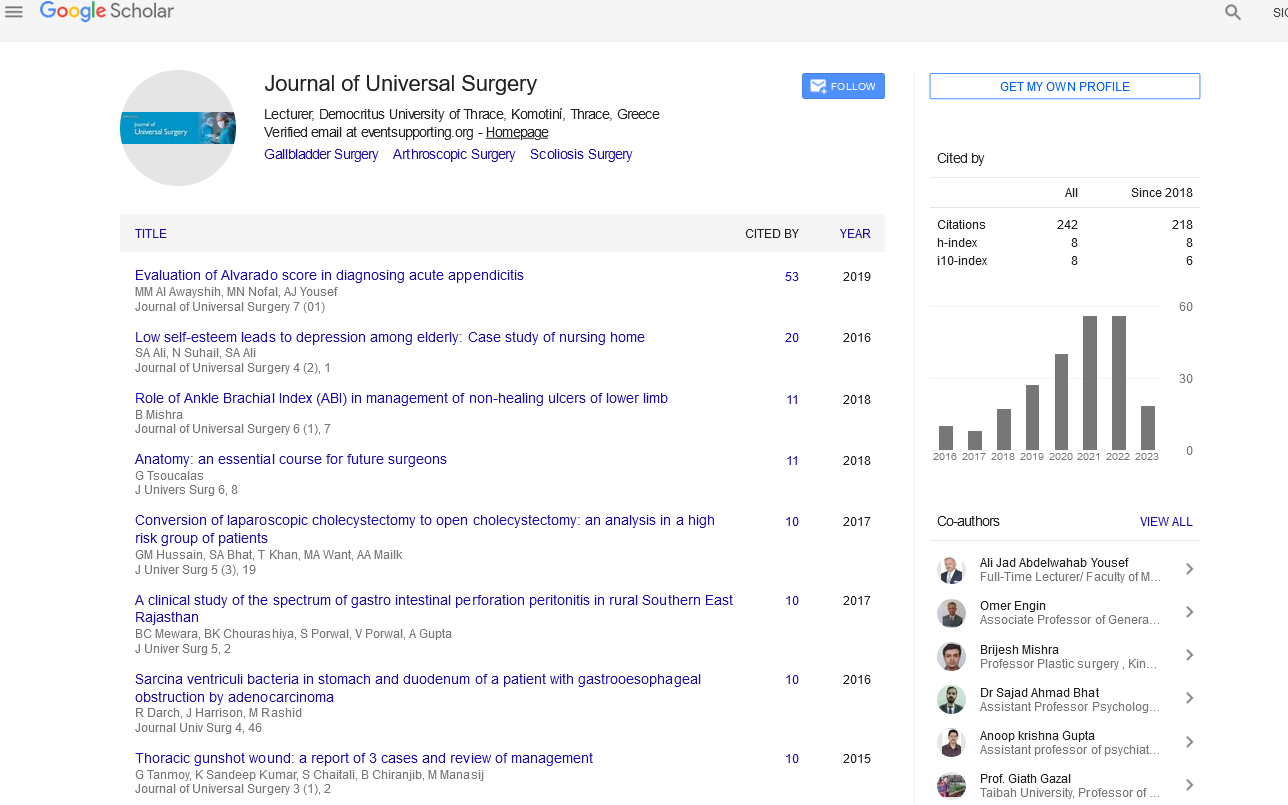Perspective - (2024) Volume 12, Issue 6
Surgery Precautions Taken by Surgeons for Open-Heart Surgery
Sean Micheal*
Department of Cardiology, Oodi University, Oodi, Botswana
*Correspondence:
Sean Micheal, Department of Cardiology, Oodi University, Oodi,
Botswana,
Email:
Received: 26-Nov-2024, Manuscript No. IPJUS-24-15365;
Editor assigned: 29-Nov-2024, Pre QC No. IPJUS-24-15365 (PQ);
Reviewed: 13-Dec-2024, QC No. IPJUS-24-15365;
Revised: 21-Dec-2024, Manuscript No. IPJUS-24-15365 (R);
Published:
29-Dec-2024
Introduction
Open-heart surgery is a critical procedure often required for
life-threatening cardiac conditions such as coronary artery
disease, valve disorders and congenital heart defects. Given the
complexity and high stakes of the operation, surgeons take
meticulous precautions before, during and after surgery to
maximize patient safety and ensure positive outcomes. These
precautions encompass planning, sterile techniques, advanced
technology and a collaborative approach.
Description
Preoperative precautions
A thorough evaluation of the patient’s medical history,
current health status and cardiac condition is conducted.
Diagnostic tests such as echocardiograms, angiograms and CT
scans are essential to assess the severity of the problem and
plan the surgical approach. Surgeons also review coexisting
conditions like diabetes or hypertension that may increase
surgical risks.
Comprehensive patient assessment: A thorough evaluation
of the patient’s medical history, current health status and
cardiac condition is conducted. Diagnostic tests such as
echocardiograms, angiograms and CT scans are essential to
assess the severity of the problem and plan the surgical
approach. Surgeons also review coexisting conditions like
diabetes or hypertension that may increase surgical risks.
Customized surgical plan: Each surgery is tailored to the
patient’s needs. Surgeons decide on the type of procedurewhether
it’s valve repair, bypass surgery or congenital defect
correction. The use of heart-lung bypass machines is also
evaluated.
Medication review and management: Patients are advised to
stop certain medications, such as blood thinners, to reduce the
risk of excessive bleeding. Preoperative antibiotics may be
administered to minimize the risk of infection.
Pre-surgical counseling: Surgeons discuss potential risks,
benefits, and the recovery process with the patient and their
family. Emotional preparedness is essential, as stress or anxiety
can affect surgical outcomes.
Intraoperative precautions
Maintenance of sterile environment: The operating room is
sterilized rigorously to eliminate any potential sources of
infection. Surgeons and the surgical team adhere to strict aseptic
protocols, including wearing sterile gloves, masks and gowns.
Use of advanced monitoring systems: Sophisticated
monitoring systems are used to track the patient’s vital signs,
including heart rate, oxygen levels and blood pressure. These
tools help detect any abnormalities in real-time.
Surgical risks and complications
Even with advanced surgical techniques, glaucoma surgeries
such as trabeculectomy or glaucoma drainage devices carry
inherent risks. Complications such as infection, bleb failure,
scarring and hypotony can result in poor surgical outcomes or
even worsen vision loss.
Solution: Recent advancements in Minimally Invasive
Glaucoma Surgery (MIGS) offer a safer alternative with fewer
complications. However, MIGS is not suitable for all glaucoma
types, necessitating a tailored approach for each patient.
Limited access to specialized care
Access to glaucoma specialists and surgical facilities is a
significant barrier, particularly in low-income and rural areas.
The shortage of trained ophthalmic surgeons and the lack of
specialized equipment hinder timely surgical interventions.
Solution: Investments in healthcare infrastructure and the trai
ning of general ophthalmologists in glaucoma management can
address this gap. Telemedicine and remote consultations can
also help bridge the accessibility divide.
Economic constraints
Glaucoma surgeries, especially advanced procedures, can be
prohibitively expensive for many patients. The costs associated
with preoperative diagnostics, surgical fees, postoperative care
and medications pose a substantial burden, particularly in
countries without robust health insurance systems.
Solution: Government subsidies, non-profit healthcare
initiatives and insurance schemes can make glaucoma surgery more affordable. Outreach programs providing free or subsidized
surgeries in underserved regions can help mitigate financial
barriers.
Medication non-adherence before and after surgery
Non-adherence to prescribed medications is a prevalent issue
in glaucoma management. Patients often fail to follow
preoperative regimens that optimize surgical outcomes.
Similarly, postoperative medication non-compliance can lead to
complications such as infection or poor wound healing.
Solution: Patient education is crucial to improving adherence.
Simplifying medication regimens, using fixed-dose combinations
and involving caregivers in the process can enhance compliance.
Regular follow-up and reminders can also reduce the risk of nonadherence.
Cultural and psychological barriers
Cultural beliefs and psychological factors often deter patients
from seeking surgical interventions. Fear of blindness, distrust in
medical procedures or reliance on traditional remedies can
delay or prevent surgery.
Solution: Culturally sensitive health education programs
addressing myths and misconceptions about glaucoma surgery
can help build trust and encourage timely interventions.
Psychological counseling and peer support groups can also
alleviate anxiety related to surgery.
Postoperative care challenges
Effective postoperative care is vital for the success of
glaucoma surgery. However, factors such as inadequate patient
follow-up, lack of access to healthcare facilities and poor wound
care practices can lead to suboptimal outcomes.
Solution: Providing clear postoperative care instructions and
scheduling regular follow-ups are essential. Mobile health units
and teleconsultations can support patients in remote areas.
Training local healthcare workers to manage basic postoperative
needs can also be beneficial.
Conclusion
Medical barriers to glaucoma surgery are multifaceted,
ranging from delayed diagnosis and patient comorbidities to
economic and cultural challenges. Addressing these barriers
requires a holistic approach involving advancements in
technology, patient education, improved access to care and
multidisciplinary collaboration. By overcoming these obstacles,
healthcare systems can ensure timely and effective surgical
interventions, ultimately preserving vision and improving the
quality of life for glaucoma patients.
Through concerted efforts, the global community can make
significant strides in breaking down the barriers to glaucoma
surgery, paving the way for a brighter and clearer future for
millions at risk of blindness.
Citation: Micheal S (2024) Surgery Precautions Taken by Surgeons for Open-Heart Surgery. J Univ Surg Vol.12 No.6: 057.





